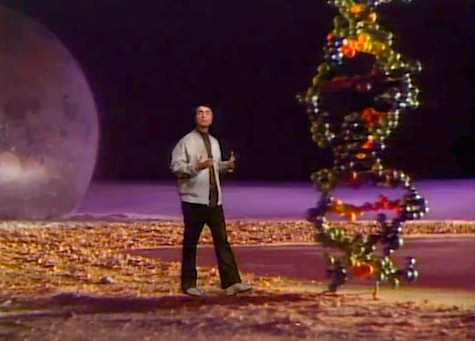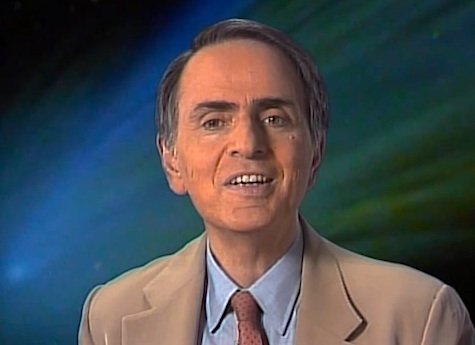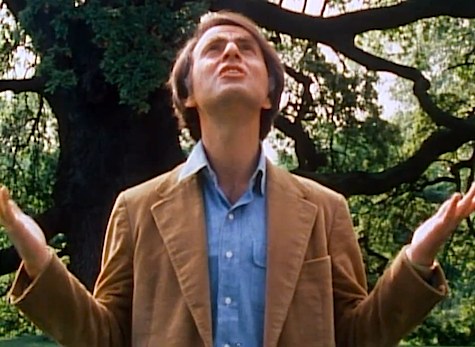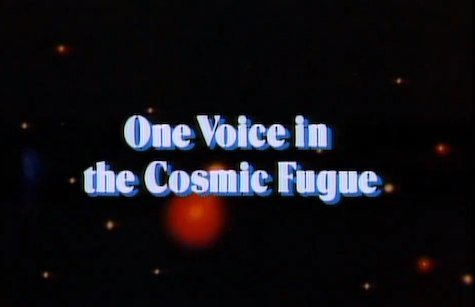The second episode of Cosmos, “One Voice in the Cosmic Fugue,” is an exploration of evolution from various approaches: historical, scientific, and contextual. An overarching concern with the order of the universe and our interconnectedness with it is again a major contextual factor here. As Sagan says in the episode’s introduction, “The nature of life on earth and the quest for life elsewhere are two sides of the same question: the search for who we are.” He uses a discussion of Earth’s development of life to introduce a consideration of how life may appear elsewhere in the universe, and how all of these things are related.
In “One Voice in the Cosmic Fugue,” there’s science, speculation, and also some neat animations. The title also provides the episode with a delightful reoccurring metaphor, which Sagan uses to contrast the one “voice” we know, Earth’s evolution and intensely connected life, to the possibilities out there in space. Are we alone, “…or is there a cosmic fugue, a billion different voices playing the life music of the galaxy?”
This is an episode with an intriguingly circular narrative structure and a heavy emphasis on facts. It begins with a fairly straight-forward question, “How did life evolve to produce beings as elaborate and complex as we, able to explore the mystery of our own origins?”, but where it goes from there is anything but straightforward. Instead, I’d call it playfully nonlinear.
First, Sagan locates us in a moment of history in 12th century Japan, where one clan is wiped out by another, resulting in the suicide of the clan’s child emperor. The sudden jump to a mythologized history is a little odd, at first, until we see where it’s going: the inland sea where these folks died now has crabs that appear to have the faces of samurai on their backs. Using this jumping-off point, Sagan takes us through a gentle example of artificial selection: the crabs that appeared to have human faces were thrown back by the fishermen and reproduced, but the ones without the eerie face-markings were eaten. Therefore, over time, we ended up with more crabs that had the markings than not.
The crab example eases the viewer into the concept of evolution before throwing it right out there; I would like to call it a sign of the times, but I don’t think the strategy is ill-placed now, either. Then, having done the easing-in maneuver, Sagan makes a clever, rather grand statement: “If artificial selection makes such changes in only a few thousand years, what must natural selection, working for billions of years, be capable of? The answer is all the beauty and diversity in the biological world. […] Evolution is a fact, not a theory—it really happened.” From there, we explore evolution from the first living molecules up through humanity. The cosmic calendar comes into play again, too, to show the scale of how long evolution took to end up at the current state of things. (I’m beginning to appreciate the rhetorical strategy of the calendar; it definitely has a strong convincing effect when it comes to displaying scale.)
Once the journey from the first moment of life up to now has been made, we step sideways in the narrative to consider the contexts for that history. We take an internal journey to the thing that connects us all: DNA. Sagan gives a fast-and-clear run down of how cells work, how DNA replicates, etc. He also notes the scale and scope in an apt comparison: “There are as many atoms in one molecule of DNA as there are stars in a typical galaxy.” Sagan also explains a science experiment trying to devise how the first living molecules came to be, and then goes into an extrapolative experiment about an alien species called “floaters.” That he frames both of these as experiments is fun and revealing: the imagination is as powerful for doing science, he implies here, as are the concrete, provable tools and results.

Sagan closes by tying the end of this circular, in-and-out biological journey to Cosmos’s concern with connections and contexts: “For the first time, as we will see, we’ve begun a serious search for the cosmic fugue.”
(There is also an update from 10 years later about new discoveries regarding RNA, comets, and new theories on the extinction of dinosaurs—and it’s damn hard to remember that all of that was new knowledge around 1990. That wasn’t exactly long ago.)

“One Voice in the Cosmic Fugue” is a fascinating episode, structurally, as I’ve tried to map out in the summary (which went on a little long this time, sorry). The structure itself reminds me of a spiral, or perhaps a Möbius strip. Where we begin goes sideways into an example that is used to ease us toward a discussion of the true topic; from that point, we go back and forward in time, then into and out of cells themselves, finally leaping into the extrapolative in a time and place that does not yet exist. And, from that far-flung imaginative place, we shift back to the very point where we began: understanding the cosmos by understanding the nature of biological life on Earth, paradoxically taking an intuitive step outside the self-centered nature of human science by going further into ourselves.
Aside from that free-flowing narrative structure, the episode also offers a comprehensive introductory guide to the theories of natural selection, artificial selection, evolution, and cellular biology. That was more fun when it was all fresh and new, but the tour back through familiar territory is still enjoyable with Sagan as the narrator. This biological guide is doing something else, too, in a way that will be familiar to folks who’ve seen Cosmos before: it’s making, in a sense, a vaguely spiritual and entirely scientific claim of connection between all living things. Sagan is interested in unity and harmony; Cosmos seeks to explain the naturalness of this harmony in a lot of different ways in its different episodes. This one takes the biological track, and makes a pretty damn strong point about our building blocks—all people, all plants, all living matter—being intimately related.
I had forgotten, also, that Sagan goes further in this episode than merely stating the facts about the un-deniability of evolution—he also makes an argument against the idea of intelligent design, though he does it gently. His line here is memorable, to me at least. After he introduces the “human” concept of a creator or proverbial “watchmaker,” he posits that “there’s another way, equally human and far more compelling: natural selection, which makes the music of life more beautiful as the eons pass.” (This sentiment will be echoed decades later by Richard Dawkins in the text of The Greatest Show on Earth—a book I’m going to go ahead and say likely wouldn’t exist in the form that it does without Cosmos.) Heady stuff.
The closing third of the episode is also moving and intriguing. Sagan’s aliens are eerie and provocative, but the strength of the episode lies in its concern with building an implicit narrative for all life on earth and how we affect other living things. In this context, I can certainly imagine an update in the new series about genetic modifications and all of the strange, mad-science things we’ve developed the ability to do since 1980.

So, why is it all important? In a way, by examining ourselves we come to know the cosmos—because we are the cosmos, embodied, as Sagan argued in the series’ introductory episode. As he says at the close of this episode, “Biology is more like history than it is like physics: you have to know the past to understand the present. There’s no predictive theory of biology just as there’s no predictive theory of history. The reason is the same: both subjects are still too complicated for us. But we can understand ourselves much better by understanding other cases.” The context, therefore, is what’s golden—the context is what makes our world even slightly intelligible to us, and allows us to make leaps of imagination as well. We search for those other voices, those others methods of life, by examining both the internal structures of life on Earth and by postulating external, otherwise structures—driven by curiosity and the power of knowing.
While the first episode is like an abstract, “One Voice in the Cosmic Fugue” is a full-blown research essay on evolutionary biology and its place in our understanding of ourselves, the world around us, and the worlds we can’t yet know. Crunchy and interesting, whether the actual data is a bit dated or not.
Join us in a week for a discussion of episode 3, “The Harmony of the Worlds.”
Lee Mandelo is a writer, critic, and editor whose primary fields of interest are speculative fiction and queer literature, especially when the two coincide. She can be found on Twitter or her website.










